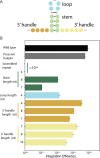This is a preprint.
Distinct horizontal transfer mechanisms for type I and type V CRISPR-associated transposons
- PMID: 37502928
- PMCID: PMC10369902
- DOI: 10.1101/2023.03.03.531003
Distinct horizontal transfer mechanisms for type I and type V CRISPR-associated transposons
Update in
-
Distinct horizontal transfer mechanisms for type I and type V CRISPR-associated transposons.Nat Commun. 2024 Aug 6;15(1):6653. doi: 10.1038/s41467-024-50816-w. Nat Commun. 2024. PMID: 39103341 Free PMC article.
Abstract
CRISPR-associated transposons (CASTs) co-opt CRISPR-Cas proteins and Tn7-family transposons for RNA-guided vertical and horizontal transmission. CASTs encode minimal CRISPR arrays but can't acquire new spacers. Here, we show that CASTs instead co-opt defense-associated CRISPR arrays for horizontal transmission. A bioinformatic analysis shows that all CAST sub-types co-occur with defense-associated CRISPR-Cas systems. Using an E. coli quantitative transposition assay, we show that CASTs use CRISPR RNAs (crRNAs) from these defense systems for horizontal gene transfer. A high-resolution structure of the type I-F CAST-Cascade in complex with a type III-B crRNA reveals that Cas6 recognizes direct repeats via sequence-independent π - π interactions. In addition to using heterologous CRISPR arrays, type V CASTs can also transpose via a crRNA-independent unguided mechanism, even when the S15 co-factor is over-expressed. Over-expressing S15 and the trans-activating CRISPR RNA (tracrRNA) or a single guide RNA (sgRNA) reduces, but does not abrogate, off-target integration for type V CASTs. Exploiting new spacers in defense-associated CRISPR arrays explains how CASTs horizontally transfer to new hosts. More broadly, this work will guide further efforts to engineer the activity and specificity of CASTs for gene editing applications.
Keywords: Tn7; g ene editing; mobile genetic element; transposon.
Conflict of interest statement
Declaration of Interests K.H., C.O.W. and I.J.F. have filed a patent application relating to CRISPR-associated transposons.
Figures






References
-
- Barrangou R. & Horvath P. A decade of discovery: CRISPR functions and applications. Nature microbiology 2, 1–9 (2017). - PubMed
-
- Marraffini L. A. CRISPR-Cas immunity in prokaryotes. Nature 526, 55–61 (2015). - PubMed
-
- Mohanraju P. et al. Diverse evolutionary roots and mechanistic variations of the CRISPR-Cas systems. Science 353, aad5147 (2016). - PubMed
-
- Faure G., Makarova K. S. & Koonin E. V. CRISPR–Cas: complex functional networks and multiple roles beyond adaptive immunity. Journal of molecular biology 431, 3–20 (2019). - PubMed
Publication types
Grants and funding
LinkOut - more resources
Full Text Sources
Research Materials
Miscellaneous
